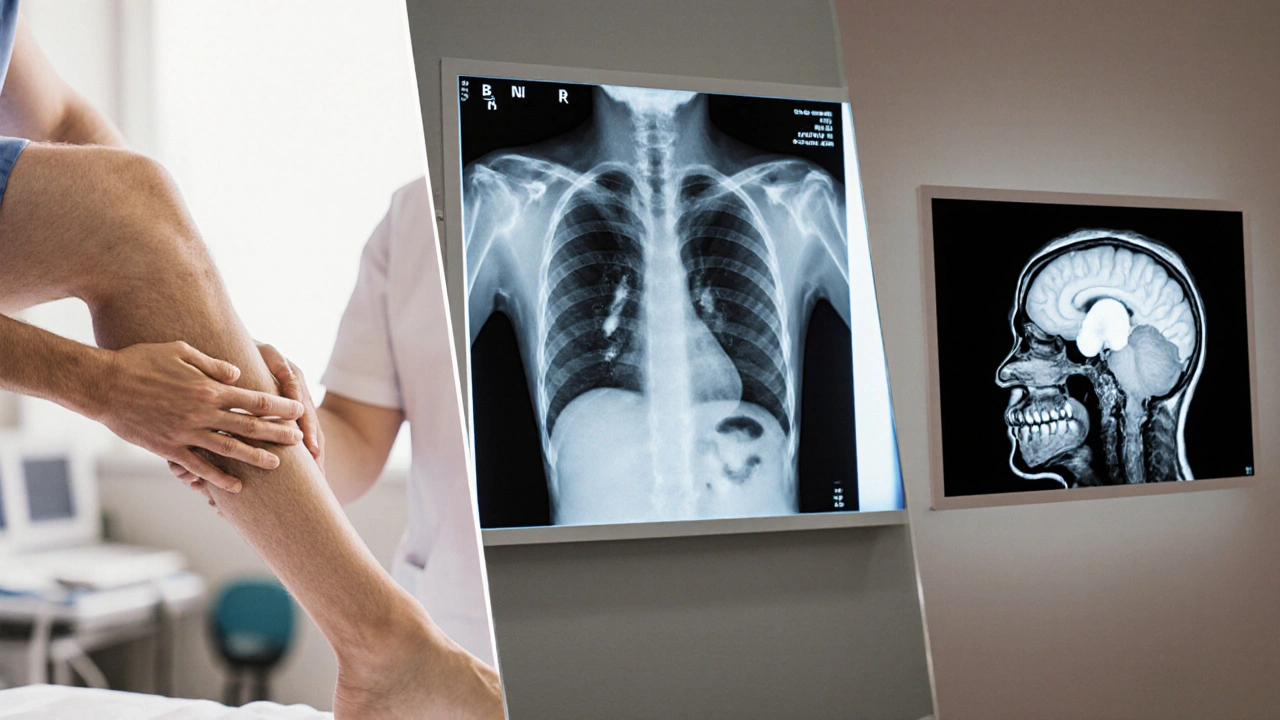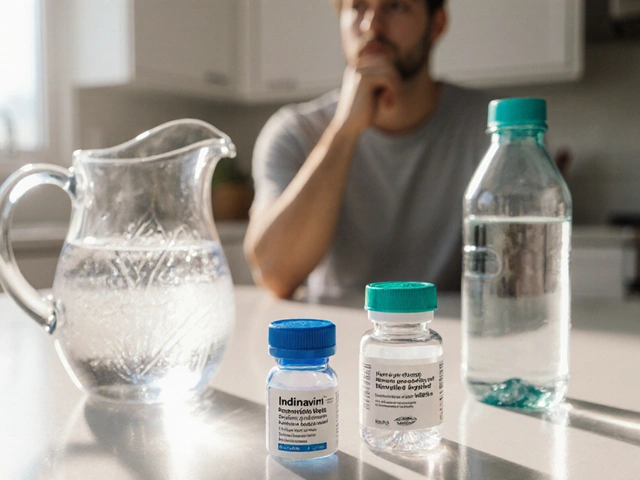When fluid builds up where it shouldn’t, the swelling you see is called Edema - a medical condition marked by excess fluid in the body’s tissues. It can appear as a puffier ankle, a tight chest, or even a bulging head, depending on where the fluid gathers. Knowing the different patterns helps you catch a problem early, decide whether a home remedy will do, or understand when a doctor’s visit is urgent.
Key Takeaways
- Edema isn’t one‑size‑fits‑all; each type has a typical location and cause.
- Peripheral edema shows up in legs and feet, while pulmonary edema affects breathing.
- Lymphedema feels heavy and often follows surgery or infection.
- Sudden swelling, pain, or shortness of breath should trigger a medical check.
- Simple steps-elevating legs, reducing salt, staying active-help many mild cases.
What Is Edema?
At its core, edema is an imbalance between fluid filtration out of blood vessels and drainage back into the circulatory system. When the lymphatic network or veins can’t keep up, fluid pools in the interstitial space, stretching the skin. Common triggers include high sodium intake, heart failure, kidney disease, and inflammation.
Major Types of Edema
Below is a quick snapshot of the most frequently encountered forms.
| Type | Typical Location | Key Symptoms | Common Causes |
|---|---|---|---|
| Peripheral edema | Feet, ankles, lower legs | puffy skin, dull ache, better after elevation | Venous insufficiency, prolonged standing, heart failure |
| Pulmonary edema | Alveolar spaces in lungs | shortness of breath, rapid breathing, frothy sputum | Left‑sided heart failure, high altitude, inhalation injury |
| Cerebral edema | Brain tissue | headache, nausea, altered consciousness | trauma, infection, stroke |
| Lymphedema | Arms or legs (often one side) | tight, heavy feeling, skin thickening | lymph node removal, radiation, filariasis |
| Idiopathic edema | Hands, feet, face (fluctuates daily) | swelling that worsens by evening, recovers overnight | unknown; often hormonal or vascular sensitivity |
| Cardiac edema | Legs, abdomen (ascites) | shortness of breath, fatigue, weight gain | congestive heart failure, poor pumping function |
| Renal edema | Whole body or localized | puffy eyes, swelling of hands, reduced urine | chronic kidney disease, nephrotic syndrome |

How to Identify Each Type
Spotting the pattern matters more than the label. Here’s what to look for.
- Peripheral edema: Press the skin on the shin; a lasting indentation (pitting) hints at fluid excess. Swelling often worsens after a day of standing and eases when legs are raised.
- Pulmonary edema: Rapid, shallow breaths, a feeling of drowning, or a wheezy cough that produces frothy pink sputum are red flags. Listening with a stethoscope reveals crackles at the lung bases.
- Cerebral edema: New or worsening headache, vomiting, blurred vision, or difficulty walking suggests the brain is swelling. Prompt imaging (CT or MRI) is essential.
- Lymphedema: The affected limb feels heavy, skin may develop a "peau d’orange" texture, and the swelling rarely resolves with simple elevation.
- Idiopathic edema: Swelling peaks in the late afternoon and disappears after a night's rest. Hormonal swings in women can intensify the pattern.
- Cardiac edema: Alongside leg swelling, you’ll notice shortness of breath when lying flat (orthopnea) and a persistent cough.
- Renal edema: Puffy eyelids upon waking, ankle swelling, and reduced urine output point toward kidney involvement.
Diagnostic Tools You May Encounter
Doctors use a mix of bedside checks and tech to pin down the cause.
- Physical exam - pitting test, pulse, and blood pressure.
- Blood work - includes creatinine, electrolytes, and B‑type natriuretic peptide (BNP) for heart stress.
- Urine analysis - looks for protein (nephrotic syndrome) or excess sodium.
- Imaging - chest X‑ray for pulmonary edema, ultrasound of veins for deep‑vein thrombosis, MRI for cerebral edema.
- Lymphoscintigraphy - a special scan to map lymph flow when lymphedema is suspected.

General Management Strategies
While the root cause dictates long‑term therapy, a few universal steps often help.
- Reduce sodium intake to less than 2grams per day; this cuts fluid retention.
- Stay active - gentle walking promotes venous return.
- Elevate swollen limbs above heart level for 15‑20minutes, three times a day.
- Wear compression garments (graded 20‑30mmHg) if recommended by a clinician.
- Diuretics are prescribed for cardiac or renal edema, but they require medical supervision.
When to Seek Medical Help
Not all swelling is harmless. Use this quick checklist.
- Sudden onset of swelling in one leg or arm.
- Shortness of breath, chest pain, or coughing up frothy fluid.
- Swelling accompanied by fever, redness, or warmth (possible infection).
- Neurological signs - confusion, seizures, or loss of consciousness.
- Swelling that doesn’t improve after 48hours of home care.
Frequently Asked Questions
Can I treat edema at home without medication?
Mild peripheral edema often improves with lifestyle changes: lower salt, leg elevation, and regular movement. Compression stockings can add support, but if swelling persists or worsens, a doctor should evaluate you.
Why does my ankle swell more in the evening?
Gravity pulls fluid down throughout the day. Without adequate venous return, the ankle tissue retains water, producing noticeable evening puffiness. Raising the legs before bed often reverses this.
Is swelling of the face a sign of something serious?
Facial edema can stem from allergies, sinus infections, or hormonal shifts, but sudden, painful swelling may signal angioedema, which can affect breathing and needs urgent care.
How does kidney disease cause edema?
Damaged kidneys fail to excrete sodium and water efficiently, raising blood volume and forcing fluid out of vessels into tissue, especially around the eyes and ankles.
What’s the difference between pitting and non‑pitting edema?
Pressing on pitting edema leaves a temporary indentation; it’s typical of fluid overload. Non‑pitting edema feels firm, often linked to lymphatic blockage or thyroid disease.
Understanding the various edema types equips you to spot warning signs early and choose the right next step-whether that’s a home remedy, a telehealth consult, or an urgent ER visit.





chioma uche
People in Nigeria have been dealing with swelling issues for years while the West pats itself on the back for publishing fancy articles. The truth is that our hospitals lack basic diuretics, and most patients just suffer in silence. If you think a table of symptoms will cure anyone, think again. We need real action, not just glossy descriptions.
Vishnu Raghunath
Oh great, another deep dive into fluid that refuses to leave your ankles. Because that's exactly what my day was missing – more medical jargon. I'm sure the next step is to sprinkle salt on everything and call it a solution.
Aparna Dheep
Life is a delicate balance of pressure and release and edema perfectly illustrates that the body mirrors the cosmos we are constantly seeking equilibrium without ever truly achieving it the swelling is just a reminder that we cannot outrun our own biology and that humility should guide our approach to treatment
Nicole Powell
While passion is admirable the article already covers the medical basics thoroughly there is no need to turn the discussion into a political rant the focus should remain on evidence based management such as leg elevation low sodium diet and proper compression therapy
Ananthu Selvan
Seriously? You act like this is some theatrical performance but the reality is people actually die from pulmonary edema and your sarcasm does nothing but trivialize a life‑threatening condition
Nicole Chabot
Actually the lifestyle steps mentioned-like reducing sodium to under 2 grams and walking daily-are simple yet often overlooked and they work for many patients with peripheral edema. If you combine them with proper medical follow‑up the outcomes improve dramatically.
Sandra Maurais
The presented taxonomy of edema types is comprehensive yet suffers from a lack of quantitative prevalence data. A meta‑analysis of epidemiological studies would strengthen the discussion, particularly regarding the incidence of lymphedema post‑oncologic surgery. Moreover, the recommendation to use compression garments should be accompanied by references to pressure gradation standards. Overall, the article is a solid foundation but would benefit from additional scholarly citations.
Michelle Adamick
Wow, great analysis! 🙌 Adding those extra stats will make the piece rock solid 📊💪 Keep pushing the data, we’re all here for it! 😄
Edward Glasscote
Leg elevation works better than most meds.
Gaurav Joshi
That’s an over‑simplification; without addressing underlying cardiac function elevation alone won’t resolve chronic edema.
Jennifer Castaneda
Don’t be fooled by the clean tables – the pharmaceutical industry is hiding the real side effects of diuretics, and those “simple” recommendations are part of a larger agenda to keep patients dependent on prescription drugs.
Annie Eun
The fear‑mongering is palpable, yet it’s essential to recognize that uncontrolled fluid retention can indeed be a gateway to severe complications, so vigilance remains key despite conspiratorial whispers.
Jay Kay
Just a heads up: the pitting test is a quick bedside trick that can differentiate between fluid overload and lymphatic blockage without any fancy equipment.
Franco WR
Edema is a symptom that many people overlook until it becomes uncomfortable or alarming, and that first sign is often a subtle tightening around the ankle or a slight puffiness that people attribute to a long day of standing. The underlying physiology involves the hydrostatic and oncotic pressures that normally keep fluids within the vasculature, but when these forces become unbalanced, fluid leaks into the interstitial spaces. In many cases, simple lifestyle adjustments such as reducing dietary sodium, increasing physical activity, and elevating the affected limbs can make a noticeable difference within a few days. However, it is crucial to recognize that these measures are only supportive and not curative for the root cause, which may be cardiac, renal, hepatic, or lymphatic in nature. For instance, left‑sided heart failure can cause pulmonary edema, leading to shortness of breath and frothy sputum, a condition that demands immediate medical intervention. Renal disease, on the other hand, reduces the kidneys’ ability to excrete excess fluid and sodium, resulting in generalized swelling that often starts around the eyes. Lymphedema tends to present as a non‑pitting, firm swelling that does not improve with elevation and may require specialized compression therapy and manual lymphatic drainage. When evaluating a patient, clinicians will typically start with a thorough history and physical exam, checking for pitting, skin changes, and distribution patterns. Laboratory tests such as BNP for cardiac stress, serum creatinine for kidney function, and urinalysis for protein loss help narrow down the etiology. Imaging studies ranging from chest X‑rays to MRIs can further delineate fluid accumulation in specific organs. The role of diuretics, while valuable in managing volume overload, must be carefully balanced against potential electrolyte disturbances and renal impairment. Patient education is also a cornerstone; teaching individuals how to monitor their weight daily can provide early warnings of fluid retention. Moreover, community resources such as support groups for lymphedema patients can improve adherence to compression garment use and physiotherapy. Finally, if swelling persists despite home measures, it is imperative to seek professional care to rule out serious underlying conditions and to tailor a targeted treatment plan.
Rachelle Dodge
Excellent overview; just remember to mention that weight tracking is a low‑cost self‑monitoring tool.
Gaurav Joshi
I’m curious about how altitude exposure influences pulmonary edema; does the reduced atmospheric pressure exacerbate fluid leakage in susceptible individuals?
Elaine Proffitt
Altitude does increase the risk because lower oxygen tension raises pulmonary artery pressure which can lead to fluid seepage into the alveoli especially in those with underlying heart issues
Christopher Munt
Great point! 🌍 Monitoring altitude effects can help hikers and pilots stay safe. 🏔️✈️